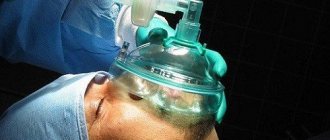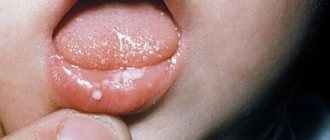Indications and contraindications for general anesthesia
Indications for general anesthesia are limited to the need for surgical intervention. The depth of anesthesia depends on the planned operation and its traumatic nature, expected duration, degree of muscle relaxation, establishment of artificial ventilation and other features of surgical treatment.
The main goal of general anesthesia is an adequate level of pain relief and absence of consciousness, which eliminates the effect of being present at the operation as in the case of spinal or local anesthesia. The anesthesia should be deep enough for the operation to be performed comfortably, and, at the same time, should not be deeper than an acceptable and safe level.
Contraindications to general anesthesia are absolute only in the case of planned operations, when it is possible to either correct the patient’s condition or choose a different method of anesthesia. During emergency operations, when it comes to saving the patient’s life, general anesthesia is performed in any case.
The following are considered obstacles to routine general anesthesia:
- Diseases of internal organs and the endocrine system in the stage of decompensation;
- Arrhythmias, regardless of the causative factor;
- Severe bronchial asthma;
- Myocardial infarction or stroke in the next six months;
- Acute alcohol, drug intoxication;
- A full stomach is a relative contraindication.
In pediatric practice, the need for anesthesia is treated very carefully. If the operation can be postponed to a later date, it will be temporarily abandoned. It is safer to administer anesthesia to children over the age of four. In emergency cases, there is no choice, and babies are given anesthetics even during the newborn period, carefully calculating the safe dosage.
Does it hurt to get an injection in the gum?
As for the psychological fear of whether it hurts to put an injection in the gum, in most cases it is not justified.
A thin needle is used for the injection and, accordingly, the destruction of surface tissue is insignificant, and the pain is not at all severe.
In addition, you will not have to endure the pain for long – just a few seconds.
This is much better than prolonged toothache and possible complications if left untreated.
A good and experienced doctor psychologically prepares the patient for the fact that there will be no pain during the injection and, accordingly, there is absolutely nothing to fear. The absence of psychological fear will have a positive effect on the effectiveness of treatment.
Stages of general anesthesia
The drugs used for anesthesia have a complex mechanism of action and are capable of causing peculiar changes in organs that fall into several phases, corresponding to the degree of tissue saturation with anesthetics. The use of combinations of anesthetics allows not only to reduce their toxic effect due to a lower dose, but also to make induction and recovery from anesthesia more comfortable for the patient.
Based on the depth of anesthesia, there are several stages of anesthesia:
- Analgesia stage.
- Excitation.
- Surgical anesthesia.
- Awakening.
In the first stage, pain sensitivity in the nerve centers of the brain is blocked. The patient is still conscious, but seems to be stunned, may be inhibited, and less often, shows anxiety. During the analgesia stage, an increase in heart rate is noted, muscle tone may increase, and pain sensitivity disappears. Further administration of anesthetics will lead to deepening of anesthesia. The analgesia stage is sufficient for short-term manipulations - drainage of abscesses, some invasive examination methods, etc. The duration of the first stage of general anesthesia is only a few minutes.
As the drugs are further administered, the patient's consciousness disappears, but motor reactions intensify, which is associated with excitation of the subcortical brain centers. Against the background of absent consciousness, motor agitation, increased muscle tone, erratic movements of the limbs, and even attempts to get up and leave the operating room on their own are noted.
In the stage of excitement , breathing and pulse become more frequent, an increase in blood pressure, redness of the skin, dilation of the pupils, increased production of mucus by the bronchial glands, sweating, salivation and lacrimation are characteristic. During this phase, vomiting with the risk of aspiration of gastric contents, reflex respiratory arrest, severe arrhythmia and death are possible.
Unlike the first stage, which allows for minor interventions without additional deepening of anesthesia, the second stage of the action of anesthetics is not suitable for any manipulations and requires continued saturation of the tissues with drugs. Its average duration is 7-15 minutes.
The third phase of general anesthesia is surgical, which has several levels depending on the concentration of anesthetics and the depth of anesthesia. At this stage, the patient calms down, the correct rhythm and frequency of breathing and heartbeat are restored, and the pressure is close to normal values. Complete loss of sensation and loss of consciousness allows a variety of operations to be performed during the stage of surgical anesthesia.
Surgical anesthesia has 4 levels:
At the first level , the operated patient is calm, breathing, heartbeat, blood pressure are close to normal, the eyes move smoothly, the pupils constrict to the light. Due to the preservation of muscle tone, abdominal interventions are not performed during this phase;- The second level is characterized by the absence of eye movement, which are located centrally, the pupils are dilated, and the reaction to light weakens. Breathing, heartbeat, blood pressure are within normal limits. Reflexes and muscle tone decrease, so abdominal surgery is possible;
- The third level corresponds to deep anesthesia, when the pupils constrict only in strong light, the muscles relax completely, breathing is disrupted, becoming superficial due to muscle atony. Facial atony causes the jaw to sag, the larynx to close with the root of the tongue, as a result of which spontaneous breathing stops. Characterized by increased heart rate and hypotension. Anesthesia is not brought to this stage due to the risk to life;
- The deepest general anesthesia corresponds to the fourth stage: the pupil is dilated, does not respond to a light stimulus, muscle atony increases, the intercostal spaces do not contract, tachycardia increases, breathing is shallow, hypotension is pronounced. Such anesthesia is life-threatening; the heart and breathing can stop at any moment.
The operations are carried out in stages I or II of surgical anesthesia, and after their completion the patient is gradually removed from this state - the awakening stage. The anesthesiologist stops administering medications, and the anesthesia phases proceed in the reverse order.
How to painlessly treat teeth without an injection
In some patients, the anesthetic substance can provoke serious allergies and worsening cardiovascular pathologies.
Many people intolerant to anesthetics agree to endure pain during the procedure.
But the high level of development of dental technologies relieves people with allergies from discomfort during surgery.
There are such alternative painless treatment options:
- chemical treatment of enamel with a special solvent;
- laser preparation of a diseased tooth.
- These techniques replace the drill. But such methods are not available in all dental clinics. Therefore, those who do not tolerate anesthesia and anesthesia should contact large hospitals and medical centers that practice the use of various painless techniques to combat dental pathologies.
Preparation for general anesthesia
At the stage of preparation for treatment under general anesthesia, the main role is played by the anesthesiologist, who finds out as much information as possible regarding all diseases that may in one way or another affect the course of anesthesia. It is important to ask when the last exacerbations of chronic pathology were, what the patient is constantly treated with, whether there are any allergies, whether there have been operations in the past that required anesthesia, and what the patient’s reaction to it was.
With planned treatment, the doctor has time to correct existing disorders and bring the pathology to a state of compensation. Particular attention is paid to the oral cavity, since caries can be regarded as a possible source of infection.
It is important to assess the patient's mental status, as many anesthetics can aggravate chronic mental illness. In schizophrenia, anesthetics that cause hallucinations are contraindicated. In the case of psychosis, surgery under anesthesia is impossible in principle.
When finding out the allergy history, the anesthesiologist will definitely ask if there are allergies not only to medications, but also to food, household chemicals, and plants. If you are allergic to anything, the risk of anaphylactic reactions to anesthetics increases, so antihistamines in high doses (suprastin, diphenhydramine) are used to prevent them.
For the anesthesiologist, the anatomical features of the structure of the face and chest, the length of the neck, past injuries or diseases that have deformed the cervical and thoracic spine, and the degree of development of subcutaneous fat are also important. Some features may change the nature of the intended anesthesia and the list of drugs administered, make tracheal intubation impossible, and limit the depth of anesthesia to its first stage.
One of the basic rules of the preparatory stage is the sanitation and cleansing of the digestive tract. The patient's stomach is washed with a probe (according to indications), everyone on the eve of the operation is stopped from eating and drinking for 10-12 hours, and a cleansing enema is prescribed.
Preliminary drug preparation is carried out the evening before the operation. It is aimed at normalizing the psycho-emotional state and suppressing the tone of the vagus nerve. At night, phenazepam is injected into the muscle; in case of severe anxiety, sedatives are indicated for emotionally labile subjects.
40 minutes before the scheduled intervention, narcotic analgesics are injected into the muscle or subcutaneously. Atropine helps reduce salivation and suppress the gag reflex. After premedication, the anesthesiologist inspects the oral cavity, and the removable dental structures are removed.
Types of anesthesia in dentistry
Thanks to the development of dental technologies and the emergence of effective and safe drugs, dental treatment is almost painless.
During the procedure, the patient may experience minor discomfort.
Today doctors use the following types of anesthesia:
- infiltration;
- application;
- conductor;
- intraligamentous (intraligamentary);
- stem
With infiltration anesthesia, an anesthetic is injected into the space between the periosteum and the gum mucosa. Injection of the drug quickly freezes the work area. The painkiller lasts for about an hour. Used for tooth extraction, root canal treatment, and pulp manipulation.
Application anesthesia involves applying a special spray or gel to a specific area of the gums. The effect occurs after a couple of minutes. This anesthetic is used before injection, to open abscesses, when performing manipulations at the level of the gum edge, and when removing tartar.
Conduction anesthesia is used if the surgical area is large and the use of an infiltration agent is not enough. This type of pain relief is based on blocking a branch of the trigeminal nerve. All tissues of the lower jaw become numb. The effect lasts from 30 minutes to two hours.
With the conduction type of anesthesia, discomfort may be felt due to numbness of the lips and tongue. Intraligamentary anesthesia does not have this drawback, in which the needle is directed through the gingival sulcus into the periodontal ligament from the distal and medial sides of the affected tooth. This type of anesthesia is most often chosen by dentists for children. In adults, such pain relief may be ineffective. A contraindication is the presence of a purulent periodontal pocket. Doctors use intraligamentary anesthesia for tooth preparation and extraction.
With stem anesthesia, all branches of the trigeminal nerve are blocked. This injection is used for extensive interventions (in maxillofacial surgery). Stem anesthesia anesthetizes the upper and lower jaws. After administration of such a drug, the patient's condition should be kept under control. The manipulation is carried out in a hospital setting. To increase the effectiveness and duration of local anesthetics, dentists additionally use vasoconstrictors.
Anesthesia is also used in dentistry. It is resorted to if the patient has a tendency to be allergic to local anesthetics, if the person has psychiatric and psychosomatic disorders (autism, Down syndrome, cerebral palsy, schizophrenia). In pediatric dentistry, anesthesia is used exclusively when performing complex manipulations.
Features of different types of anesthesia
After the preparatory stage, immediately before the operation, the anesthesiologist begins introducing the patient under anesthesia, carefully monitoring the pulse, pressure, and breathing. Only with the permission of the anesthesiologist will the surgeon be able to begin tissue incisions and manipulations in foci of pathology, body cavities, and internal organs.
General anesthesia can be:
- Intravenous - drugs are injected into a vein;
- Inhalation - anesthetics are inhaled.
Intravenous anesthesia is similar to short-term sleep with loss of pain sensitivity. Its advantage is the speed of achieving anesthesia, the absence of excitement, when the patient simply quickly falls asleep. The disadvantage of intravenous anesthesia is its short duration, therefore, for long operations, combinations of drugs and constant maintenance of the required concentration are required, which limits the use of intravenous anesthesia for long-term interventions.
The drugs most often used for general intravenous anesthesia are sodium thiopental and hexenal. These drugs promote rapid falling asleep without an arousal phase, and then a rapid recovery from drug-induced sleep. Anesthetic solutions are injected into the vein slowly, monitoring the patient's reaction to them.
A single use of these drugs provides anesthesia for about a quarter of an hour. If necessary, anesthetics are administered to the maximum possible dosage, constantly measuring the pressure and pulse of the patient being operated on. The doctor monitors the pupils and reflexes.
During the administration of sodium thiopental, respiratory arrest is possible, so the presence of an artificial pulmonary ventilation device in the operating room is a prerequisite for general anesthesia.
General intravenous anesthesia, when only one drug is administered, is possible for short-term interventions, lasting no more than 15-20 minutes (reduction of dislocations, curettage of the uterus, opening of abscesses, suturing after childbirth, etc.).
Ketamine, injected into a muscle or vein, is used as a general anesthetic. This drug may be remembered by patients for its hallucinogenic effect, which manifests itself at the end of anesthesia or upon recovery from it. Ketamine promotes tachycardia and increased blood pressure, therefore it is contraindicated in hypertension, but is administered for shock.
Inhalation anesthesia involves inhaling anesthetics that easily evaporate or are gaseous - fluorothan, chloroform, nitrous oxide. Entering the patient's respiratory tract through a tube, anesthetics maintain a state of sleep.
The advantage of inhalation anesthesia is considered to be a smaller dose of the drug compared to intravenous anesthesia, and there is no risk of stomach contents or blood entering the trachea, the patency of which is ensured by an endotracheal tube.
This type of anesthesia is successfully used for interventions on the head and neck, and is one of the stages of combined anesthesia for traumatic abdominal operations. The combination of intravenous and inhaled drugs allows the use of smaller doses of drugs, which reduces their toxic effect. The analgesic effect and loss of consciousness are achieved by a combination of narcotic drugs; if necessary, muscle relaxants are used to relax muscles.
General anesthesia is carried out in three stages:
tracheal intubation
Introductory anesthesia - induces sleep without arousal, achieved by using fentanyl or promolol with sombrevin, often sodium thiopental is administered. At this stage, muscle relaxants and installation of an endotracheal tube in the trachea are indicated.- Maintaining general anesthesia - drugs are administered intravenously or inhaled, muscle relaxants are used, a prerequisite is the establishment of artificial pulmonary ventilation.
- Withdrawal from general anesthesia - muscle relaxants and anesthetics are not administered, consciousness, the functioning of the respiratory system, and muscle tone are gradually restored. Once spontaneous breathing becomes possible, the anesthesiologist removes the endotracheal tube from the patient's trachea. Further observation is carried out outside the operating room.
Throughout general anesthesia, the anesthesiologist carefully monitors the state of blood circulation and regularly determines blood pressure and pulse. In case of pathology of the heart and blood vessels, operations on the chest organs, constant monitoring of heart activity is necessary.
The provision of oxygen to the patient and the nature of metabolic processes against the background of the administration of toxic anesthetics are shown by studies of blood pH, the degree of oxygen saturation, carbon dioxide levels, etc., which are carried out throughout the entire operation. All indicators are recorded by the nurse in a special card, which also includes the names and dosages of the drugs administered, the reaction to them, and any complications that have arisen.
Video: general anesthesia - broadcast from the operating room
What to do if there is pain after the injection?
First of all, you need to consult a doctor for help. If your gums hurt for a week after an anesthesia injection, this may indicate a serious pathology. The risk of serious problems increases with the appearance of purulent inflammation.
If visiting a doctor in the near future is not possible, then you should follow some recommendations:
- avoid consumption of spicy and salty foods;
- in case of severe pain, you can take a painkiller, but you should not do this often;
- do not eat too hot food;
- Avoid taking carbonated drinks, including alcohol;
- Do not use the brush as an oral hygiene tool. Instead, you can wipe your teeth and gums with a cotton pad containing hydrogen peroxide;
- do not consume solid food;
- stop smoking, as nicotine enhances the inflammatory process;
- After each meal it is necessary to rinse the mouth;
- Be sure to monitor your body temperature. Its rise can occur in a short period of time to critical values. In this case, antipyretic drugs are indicated.
Any anesthetic has a toxic effect on the liver. It negatively affects her hepatocyte cells. This is especially true after general anesthesia. Therefore, to protect it, it is necessary to take special preventive medications prescribed by the doctor. Moreover, this can be done both before and after pain relief.
We invite you to familiarize yourself with Dental overlays – types, photos, reviews
If there is no decrease in the pain response after the administration of an anesthetic in the oral cavity, we can safely talk about the development of a complication. The most important thing in this situation is not to delay the therapeutic effect on the problem.
Anesthesia is used in dentistry. There are several ways to relieve pain in the mouth. One of them is an injection of anesthetic. Consequences may occur in the form of discomfort and pain at the injection site. Let's consider the causes, methods of control, possible complications after anesthesia injection.
Injection anesthesia is the most common method of anesthesia in dentistry.
Complications and consequences of general anesthesia
Patients' fears regarding anesthesia are not unfounded. This event carries the risk of quite serious complications, the most dangerous of which is considered to be the death of the patient. These days, complications are rare, although it is impossible to completely exclude them, especially in patients with a number of concomitant complications.
Anesthesia is dangerous at any stage of anesthesia due to the effects of drugs or violation of the technique of its administration. The most common consequence is vomiting, which can cause stomach contents to enter the respiratory tract, which can cause spasm of the bronchi and larynx.
Passive ingestion of food masses is possible during deep general anesthesia without intubation or after the administration of muscle relaxants before insertion of the endotracheal tube. Pneumonia that occurs subsequently can cause death.
To prevent the complications described above, the stomach is emptied, and in some cases the probe is left in place for the entire period of anesthesia. Vomiting is also possible upon awakening, so the patient's head is turned to the side and his condition is carefully monitored.
Respiratory effects are associated with:
- Difficulty in airway patency;
- Malfunction of artificial ventilation equipment;
- Retraction of the tongue covering the larynx, pathology of the dentofacial apparatus.
When inserting a laryngoscope, injuries to teeth and laryngeal structures are possible. Violation of intubation technique can lead to the installation of a tube into the esophagus, bronchus, in rare cases it comes out of the trachea and becomes bent. These complications are caused by technical errors in the actions of the anesthesiologist.
Consequences are also provoked by the negative impact of anesthesia on the circulatory system:
- Hypotension up to collapse;
- Heart rhythm disorders - tachycardia, extrasystole, deadly ventricular fibrillation;
- Hypertension;
- Myocardial infarction;
- Pulmonary edema.
The most dangerous complication is asystole, which occurs due to insufficiently careful monitoring of the patient, technical errors, incorrect calculation of anesthetic dosages, and the presence of severe concomitant pathology. This condition requires urgent resuscitation.
The nervous system also experiences the effects of anesthetics. So, the patient’s temperature may drop slightly, and after using fluorotane, chills appear. Cerebral edema during deep and prolonged anesthesia is considered a serious consequence.
A serious complication can be an allergy to injected drugs in the form of anaphylactic shock, which is accompanied by severe hypotension, swelling of the mucous membranes of the respiratory tract, bronchospasm and requires urgent therapeutic measures.
The consequences for the body after any type of anesthesia are different. If pain relief was adequate and no complications arose, the patient recovers quickly and does not experience any difficulties due to the anesthesia. Problems rarely arise due to the need to use high doses of drugs, technical errors, or complications.
Very rarely, patients wake up before the end of the operation, and the anesthesiologist may not notice this complication. If relaxants are introduced, the patient will not be able to give any signal. At best, he does not feel pain; at worst, he feels it and hears everything that happens in the operating room.
Painful shock can lead to death, and if the person being operated on copes with the sensations during the intervention, then after the operation, problems of a psychological nature are almost inevitable - severe neuroses, depression, which will have to be dealt with for a long time and with the participation of a psychotherapist.
Some patients note memory impairment, forgetfulness, and difficulty performing habitual intellectual tasks. These cases are usually associated with frequent anesthesia, excessively deep anesthesia, and individual reactions to drugs. It is clear that any anesthesia is potentially dangerous, but it is generally accepted that general anesthesia can be done as many times as the disease requires. If the anesthesiologist is sufficiently qualified, the patient is examined, and possible risks are taken into account, then even repeated anesthesia can proceed safely and without consequences.
After general anesthesia, patients recover differently. This depends on the individual characteristics of the nervous system, the drugs used, and the duration of anesthesia. Some drugs (ketamine, for example) can cause colorful hallucinations and excitement during the period of recovery from anesthesia; after others, patients may note a feeling of weakness, heaviness in the head, drowsiness, a feeling similar to alcohol intoxication. These symptoms usually disappear within the next few hours after recovery from anesthesia, disappearing completely by the evening of the day of intervention.
Recovery after anesthesia includes early activation, pain management in the first days after surgery, and prevention of thromboembolic complications. The sooner the patient leaves the clinic, the sooner the rehabilitation period will end and the sooner he will forget that anesthesia was performed at all. If the consequences were severe, then appropriate drug treatment for complications is prescribed, a psychotherapist is consulted, and antidepressants are prescribed if necessary.
One of the most common myths regarding anesthesia is the widespread belief among ordinary people that anesthesia takes away years of life and impairs the intellect. One can hardly agree with this. Anesthesia does not shorten life or disrupt brain activity, but severe pain or refusal to operate may well cost your life.
In order for anesthesia to proceed safely, and this is usually what happens, it is important that it is carried out by a competent anesthesiologist who carefully monitors the patient’s condition, has enough information about his diseases and strictly selects the names and dosages of drugs. It is believed that any anesthesia is well tolerated if performed correctly by a qualified physician. Don't panic if you need general anesthesia. This is a necessary and mandatory component of most operations, so it makes no sense to refuse treatment out of fear.
Is it painful to treat teeth with anesthesia?
Dentists often use anesthesia when treating teeth.
Painkillers are used for:
- removal of nerves;
- tooth extraction;
- caries therapy;
- installation of crowns.
Modern medications are used for the lateral and front teeth; they effectively freeze the entire oral cavity.
Just a few minutes after the injection (applying the gel), the doctor can begin treatment. The patient does not experience any discomfort. To carry out the procedure in the most comfortable conditions, the doctor selects an anesthetic in accordance with the person’s pain threshold, taking into account the type and duration of the manipulation.











